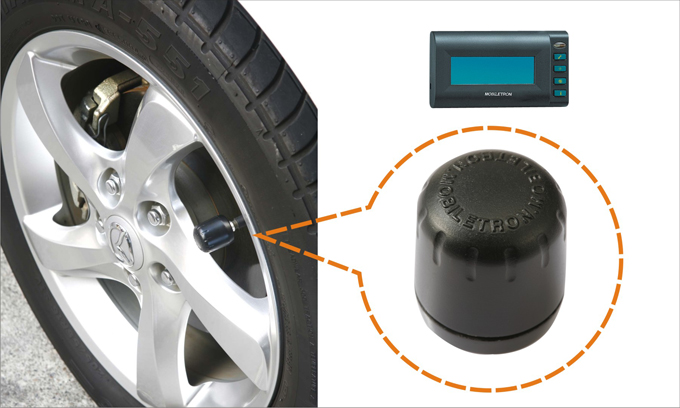Automotive MEMS Market to Surge in 2014: IHS iSuppli
2013/04/10 | By Quincy LiangWith ever advancing ITC technologies, automotive electronic systems are playing an increasingly important role to upgrade horsepower output, comfort, safety and driver convenience, hence creating great demand for microelectromechanical systems (MEMS) in the automotive segment in recent years.
Global automotive MEMS revenue is projected to reach US$2.4 billion in 2012, up 6.6% from US$2.25 billion in the previous years, according to market research firm HIS iSuppli. However, the growth rate is forecast to drop to 5.8% in 2013, due to declining global new-car sales volume, before surging to 13.4% by 2014, when revenue climbs to US%2.88 billion.
By 2016, IHS iSuppli predicts, automotive MEMS revenue will total US$3.2 billion, reflecting stabilization in the automotive MEMS sensor market due to diminishing demand for vehicle safety mechanisms like electronic stability control (ESC) and tire pressure monitoring systems (TPMS), which will see high adoption rates by that time driven by safety regulations globally.
ESC, with multiple sensors per system to detect and reduce skidding, has become increasingly common in the United States, Europe, Australia, South Korea, and Japan. TPMS, which monitors tire air pressure, is regulated in the United States, Canada, China, South Korea and Europe.
While sales of new cars are forecast to slow in Europe and China, the overall market for MEMS sensors will continue to see robust growth, benefiting the automotive segment as well, the international research firm says.
Major Growth Drivers
The global automotive MEMS market is expected to be spurred by several growth drivers after 2015.
One of them is TPMS in China, with expected sales of US$190 million. TPMS will see a later deadline of mid-2015 for mandatory fitment, helping to spur growth for the industry at a time after the system has matured in many other global regions.
Another fast-growing application, according to IHS iSuppli, will be roll detection, which is fueled by American legislation on ejection mitigation--preventing occupants of a car from being thrown out when a vehicle rolls over in an accident. The mandate will stimulate the market for gyroscopes and accelerometers for the function to 18% growth, spread out over five years.
The third growth driver will be the gasoline-direct injection (GDI)-aspirated engines, which feature higher specific power and greater efficiency, and are crucial factors to help vehicles meet forthcoming carbon emission goals in mature automotive markets.
The research firm points out that Europe is ahead of the global average in deploying GDI fuel systems. However, North America will eventually outplace the rest of the world in GDI penetration, given that gasoline engines account for most of the engine production of the continent. GDI penetration is low in China now, but will grow in the future, while Japan is on a downsizing trend with emphasis on smaller GID-turbocharged engines.
Another key sensor measurement propelling automotive MEMS market growth, according to IHS iSuppli, is the vacuum brake boost, being accelerated in particular with the advent of the stop-start application. In some automobile models pushed in recent year, the start-stop system or stop-start system automatically shuts down and restarts the internal combustion engine to reduce the amount of time the engine spends idling, thereby reducing fuel consumption and emissions. This is most advantageous for vehicles which spend significant amounts of time waiting at traffic lights or frequently come to a stop in traffic jams.
In such application, pressure sensors provide input on vacuum conditions in brake systems: depending on pressure variations during braking, a pump is activated and them generates additional vacuum to increase braking force. With growing market adhesion of start-stop systems, shipments of the device will expand by 34.5% from 2011 to 2016, reaching 18.9 million units, the research firm says.

The impending e-call telematics regulation will also stimulate sensor sales, especially for cars in Europe. Dedicated accelerometers will enjoy potential, in cars equipped with e-call systems that would automatically call the nearest emergency center in case of an accident, reducing response time considerably. The regulation, which officially kicks in at the end of the second quarter of 2015, is expected to influence all new vehicles sold in the region.
Key Categories
Four devices are making up 99% of the automotive MEMS market today, IHS iSuppli points out, including pressure sensors, accelerometers, gyroscopes, and flow sensors--all which offer five-year growth rates ranging from 3% to 12%. A fifth device, the microbolometer, a specific type of bolometer used as a detector in a thermal camera, will gain significance in 2016 when night vision systems take off, the firm adds.
While the top-five applications in terms of value this year for automotive MEMS applications are: ESC, airbags, manifold absolute pressure (MAP), TPMS and roll detection.




